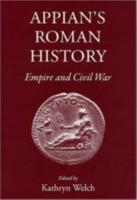
The Classical Press of Wales (2015) 326pp £62 (ISBN 9781910589007)
This must be one of the most substantial books on Roman republican history to have appeared in the last decade. Appian’s work is a major source to the understanding of the construction of the Roman empire and the fall of the republic. As W. reminds us in her introduction, much has been written about this author, but there is no comprehensive commentary available in any language, and this volume provides the first full-scale assessment in English. No serious reader of Appian, and in fact no serious student of the Roman republic, will be in a position to overlook this volume.
This is a collection of serious and demanding scholarship, produced to a very high standard (the indexes are excellent), and it does not have much to offer to the lay reader. However, its range means that it will have something meaningful to offer to a very diverse audience of classicists. Some essays may be profitably be used as extended discussions of aspects of Appian’s work, and as prolegomena to future commentaries. John Rich has a major discussion of Appian’s treatment of the wars between Rome and Antiochus III, where he convincingly shows that Appian relied extensively on his notes: a practice that makes him closer to Plutarch than many have previously suspected. Fiona Tweedie discusses his portraits of Scipio Aemilianus, drawing attention to the discrepancies between different works of the author: there is scope for a wider project on comparable cases. The late Martin Stone (whose sudden death last month has been a great loss to our studies) revisits the role of the Italic context in the narrative on Tiberius Gracchus. Kit Morrell provides an ingenious solution to the quandaries of Appian’s account of the judiciary law of M. Livius Drusus. Tom Stevenson offers a detailed analysis of the Pharsalus campaign, and W. a perceptive discussion of Appian’s narrative of triumviral history, ranging across three books of Bellum Civile. Bronwyn Hopwood has a much more concentrated analysis of the remarkable speech of Hortensia to the triumviri (4.32-34).
Other essays take a more general standpoint. Josiah Osgood offers an invaluable discussion of Appian’s intellectual and political agenda, and surveys his debt to the Augustan ideology; Richard Westall shows that Appian was a more well-read and critically aware author than has often been recognised. Jonathan Price also shows that Appian is thoroughly conversant with Thucydides’ engagement with the theme of stasis and applies it thoughtfully to the history of the late republic. Other overarching themes receive close discussion: deceit (in Eleanor Cowan’s piece) and sex (in Luke Pitcher’s). Andrew Bonnell has an informative and measured discussion of Karl Marx’s famously positive assessment of Appian’s work.
There is also something in this volume for those whose interests are mainly linguistic. Anton Powell offers an eye-opening discussion of the shortcomings of the main modern versions of Appian, chiefly that of Horace White in the Loeb Classical Library (1912-13): an accurate translation is of course key to a proper understanding of the historian’s bias. Kai Brodersen rounds off the collection with an evocative discussion of the sarcophagus of Appianos and Eutuchia, now at the German Cemetery in the Vatican, which may conceivably be that of the historian himself and his wife.
The chief ambition of this important book, reasserting the originality and importance of Appian’s work, has been amply fulfilled. The need for a new full-scale commentary remains very strong, but one is left with the impression that another task might require even more urgent attention: a new English translation of an author who is indispensable to the study and teaching of the Roman Republic.
FEDERICO SANTANGELO—Newcastle University
